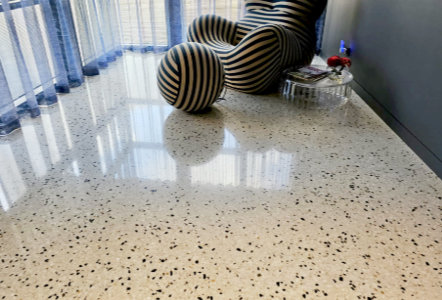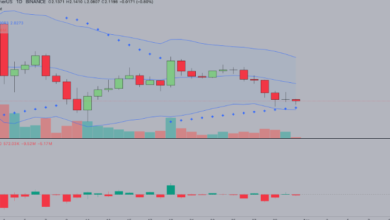Polished Exposed Aggregate Concrete: A Complete Guide

Concrete has always been a cornerstone of modern construction thanks to its strength, durability, and adaptability. Today, one of the most striking ways to elevate the appearance of concrete surfaces is through polished exposed aggregate concrete. This finish seamlessly blends durability with natural beauty, offering a sophisticated look for both residential and commercial spaces.
In this comprehensive guide, we’ll explore what polished exposed aggregate concrete is, how it’s made, its key benefits, where it can be used, maintenance tips, cost considerations, and much more.
What is Polished Exposed Aggregate Concrete?
Polished exposed aggregate concrete is a type of decorative concrete finish where the outer layer of cement paste is removed to reveal the embedded stones, pebbles, or other aggregates beneath the surface. This exposed layer is then polished using specialized machinery and abrasives to achieve a smooth, often glossy appearance.
The result is a hardwearing, attractive surface that showcases the natural textures and colors of the selected aggregates. This finish is ideal for those seeking both durability and a unique aesthetic in their concrete surfaces.
How is Polished Exposed Aggregate Concrete Created?
The creation of polished exposed aggregate concrete involves a carefully controlled process to ensure a high-quality result. The process typically includes the following steps:
Pouring and Placement
The concrete is poured using a mix that contains the chosen decorative aggregates. These aggregates can include river pebbles, crushed granite, quartz, colored stones, or even recycled materials like glass chips. The concrete must be evenly placed and leveled to ensure consistent aggregate distribution.
Exposing the Aggregate
Once the concrete has been placed, the next step is to remove the top layer of cement paste. This can be achieved through different techniques:
- Surface retarders: Chemicals are applied to slow the curing of the surface layer, which can then be washed off to expose the aggregates.
- Mechanical grinding: Specialized grinders remove the surface layer to reveal the aggregate below.
Polishing
After the aggregates are exposed, the polishing process begins. This involves using progressively finer abrasives to grind the surface until the desired level of smoothness and shine is achieved. Depending on the client’s preference, the finish can range from matte to a high-gloss, reflective surface.
Sealing
Finally, a sealer or densifier is applied to the polished surface. This protects the concrete from stains and moisture, enhances the colors of the aggregates, and increases the surface’s durability.
Benefits of Polished Exposed Aggregate Concrete
Polished exposed aggregate concrete offers a range of benefits that make it a popular choice for both interior and exterior applications.
Unique Aesthetic Appeal
One of the primary reasons people choose polished exposed aggregate concrete is for its visual impact. The natural stones and aggregates create a unique, textured appearance that can’t be replicated with plain concrete. Every installation is distinct due to the random distribution and coloration of the aggregates.
Exceptional Durability
Concrete is inherently strong, and the polishing process further enhances the surface’s hardness. This makes it highly resistant to abrasion, chipping, and wear, even in high-traffic areas.
Low Maintenance
Unlike other decorative finishes that require waxing, polishing, or frequent resurfacing, polished exposed aggregate concrete is easy to maintain. Regular sweeping and occasional mopping with a neutral cleaner are typically all that’s needed. Resealing every few years will help preserve its appearance.
Improved Safety
Even when polished, the exposed aggregates provide a naturally textured surface that offers better slip resistance than standard polished concrete. This makes it a safe option for outdoor spaces or areas where moisture might be present.
Eco-Friendly Qualities
Polished exposed aggregate concrete is a sustainable choice for several reasons. Aggregates are often locally sourced, which reduces transport emissions. The long lifespan of the surface means fewer resources are used over time for repairs or replacements. In interior settings, concrete’s thermal mass can also contribute to energy efficiency by helping regulate indoor temperatures.
Applications of Polished Exposed Aggregate Concrete
The versatility of polished exposed aggregate concrete makes it suitable for a wide variety of applications.
Residential Settings
In homes, polished exposed aggregate concrete is often used for driveways, patios, pool surrounds, garden paths, and interior floors. Its ability to blend with different architectural styles—from rustic to modern—makes it a favorite among homeowners and designers.
Commercial Spaces
Retail outlets, office buildings, hotels, showrooms, and restaurants use polished exposed aggregate concrete for its durability and upscale appearance. It withstands heavy foot traffic while adding an elegant, natural touch to the space.
Public Areas
Polished exposed aggregate concrete is also common in public infrastructure projects. Walkways, plazas, educational facilities, and civic buildings benefit from its strength and low maintenance requirements while offering a visually appealing finish.
Customization Options
A major advantage of polished exposed aggregate concrete is the range of customization options available. Here are some of the ways it can be tailored to suit a specific project:
- Aggregate selection: The type, size, shape, and color of the aggregate can dramatically alter the appearance. Options include smooth river pebbles, angular crushed granite, colored quartz, and recycled glass.
- Matrix color: The concrete itself can be tinted in various shades to complement or contrast with the aggregate.
- Polish level: The degree of shine can be customized, from a subtle matte finish to a high-gloss, mirror-like surface.
- Patterning: Saw cuts and joints can be incorporated into the design to create geometric patterns, borders, or decorative effects.
Important Considerations When Installing Polished Exposed Aggregate Concrete
Successful installation of polished exposed aggregate concrete requires careful planning and skilled execution. Some key factors to consider include:
Expertise
The process of exposing and polishing aggregate is highly specialized. It requires experienced contractors with the right equipment to achieve a uniform, attractive finish. Poor workmanship can result in uneven aggregate exposure or an inconsistent polish.
Surface Preparation
A well-prepared base is crucial to prevent cracking, settling, or other structural issues over time. The site must be properly compacted and graded before concrete is poured.
Curing Time
Concrete must cure adequately before polishing begins. Attempting to polish too soon can result in a weaker, less durable surface. The exact curing time depends on environmental conditions and the specific mix used.
Weather Conditions
For outdoor installations, weather can impact both placement and finishing. Ideally, concrete should be placed during mild conditions to avoid issues such as rapid drying or excessive moisture.
Maintenance Tips for Polished Exposed Aggregate Concrete
Maintaining polished exposed aggregate concrete is relatively straightforward and contributes to its long lifespan and continued beauty.
- Routine cleaning: Sweep the surface regularly to remove dirt and debris. For interior floors, damp mopping with a pH-neutral cleaner is recommended.
- Avoid harsh chemicals: Acidic or abrasive cleaners can damage the sealant and dull the polish over time.
- Periodic resealing: Depending on the level of traffic and exposure to the elements, the surface should be resealed every two to five years. This will help protect it from stains and wear while enhancing the color of the aggregates.
- Prompt stain removal: Spills should be cleaned up quickly to avoid staining, particularly on unsealed or worn areas.
Cost of Polished Exposed Aggregate Concrete
The cost of polished exposed aggregate concrete can vary based on several factors. These include the complexity of the design, the type of aggregate used, the level of polish desired, the size of the area, and the site conditions.
Generally, polished exposed aggregate concrete is a premium finish, but it offers excellent value given its durability, longevity, and minimal maintenance requirements. While upfront costs may be higher than plain concrete, the long-term savings on repairs, cleaning, and replacements often make it a wise investment.
Common Myths About Polished Exposed Aggregate Concrete
There are a few misconceptions about polished exposed aggregate concrete that deserve clarification.
One common myth is that polished concrete is always slippery. In reality, while high-gloss finishes can reduce traction in certain conditions, the exposed aggregate provides a natural texture that improves slip resistance. Additionally, anti-slip treatments and sealers can be applied for added safety.
Another misconception is that polished exposed aggregate concrete is only suitable for outdoor use. In fact, this finish is just as effective and attractive indoors, where it offers a durable, stylish flooring solution that complements modern and industrial design themes.
Finally, some believe that polished exposed aggregate concrete is prone to cracking. Like all concrete, it can develop hairline cracks over time, but proper installation techniques—such as appropriate joint placement and substrate preparation—greatly minimize this risk.
Read more: Navigating Complex Regulations with AI: How Modern Tech is Reshaping Compliance
Why Choose Polished Exposed Aggregate Concrete?
Polished exposed aggregate concrete is the perfect blend of form and function. It offers natural beauty through the exposed aggregates, coupled with the strength and resilience of concrete. The ability to customize the look to match your design vision makes it a versatile option for any project.
Whether you’re designing a contemporary home, upgrading a commercial space, or improving public infrastructure, polished exposed aggregate concrete provides a durable and visually impressive solution that stands the test of time.



